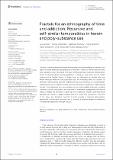Files in this item
Fractals for an ethnography of time and addiction : recursive and self-similar temporalities in heroin and poly-substance use
Item metadata
| dc.contributor.author | Roe, Laura | |
| dc.contributor.author | Dobroski, Sonja | |
| dc.contributor.author | Manley, Gabriela | |
| dc.contributor.author | Warner, Holly | |
| dc.contributor.author | Dritschel, Heidi J. | |
| dc.contributor.author | Baldacchino, Alexander M. | |
| dc.date.accessioned | 2023-02-02T09:30:11Z | |
| dc.date.available | 2023-02-02T09:30:11Z | |
| dc.date.issued | 2023-02-02 | |
| dc.identifier | 282974742 | |
| dc.identifier | 7bbdc003-029e-4f5a-ae6d-04c9c37cfef4 | |
| dc.identifier | 85148362207 | |
| dc.identifier.citation | Roe , L , Dobroski , S , Manley , G , Warner , H , Dritschel , H J & Baldacchino , A M 2023 , ' Fractals for an ethnography of time and addiction : recursive and self-similar temporalities in heroin and poly-substance use ' , Frontiers in Psychiatry , vol. 14 , 1116142 . https://doi.org/10.3389/fpsyt.2023.1116142 | en |
| dc.identifier.issn | 1664-0640 | |
| dc.identifier.other | ORCID: /0000-0002-5388-7376/work/128097204 | |
| dc.identifier.uri | https://hdl.handle.net/10023/26882 | |
| dc.description | Funding: Economic and Social Research Council (Award number(s): [ES/V011383/1].). | en |
| dc.description.abstract | Drawing on both mathematical and anthropological understandings of fractality, this paper explores alternative perspectives of time as it relates to heroin addiction and poly-substance use in Scotland. The paper ethnographically illustrates temporalities which confound typical conceptualisations of linearity, and which can be better understood as fractal. Senses of linear time are disrupted for people who use heroin through intensive poly-substance use, an increasing trend in Scotland, as both time and memory become fragmented beyond coherence or re-assemblage. Distortedness and complexity being common descriptors applied to mathematical fractals, time shattered into uncountable and un-interpretable fragments similarly connotes fracture, dissonance and distortion. A meaningful engagement with fractal theory contains the potential to open up new vocabulary, imagery, and theoretical avenues with which to grasp complex and non-linear time experience. The aims of the paper are, therefore, twofold; to both provide a nuanced ethnographic exploration of substance use time, and to develop a reflexive analytical framework for temporal experience through fractals. | |
| dc.format.extent | 6 | |
| dc.format.extent | 3311705 | |
| dc.language.iso | eng | |
| dc.relation.ispartof | Frontiers in Psychiatry | en |
| dc.subject | Addiction | en |
| dc.subject | Substance use | en |
| dc.subject | Poly-substance use | en |
| dc.subject | Time | en |
| dc.subject | Temporality | en |
| dc.subject | Fractal | en |
| dc.subject | Fractal analyses | en |
| dc.subject | Memory | en |
| dc.subject | GN Anthropology | en |
| dc.subject | RA0421 Public health. Hygiene. Preventive Medicine | en |
| dc.subject | DAS | en |
| dc.subject | SDG 3 - Good Health and Well-being | en |
| dc.subject | MCC | en |
| dc.subject.lcc | GN | en |
| dc.subject.lcc | RA0421 | en |
| dc.title | Fractals for an ethnography of time and addiction : recursive and self-similar temporalities in heroin and poly-substance use | en |
| dc.type | Journal article | en |
| dc.contributor.sponsor | Economic & Social Research Council | en |
| dc.contributor.institution | University of St Andrews. Social Anthropology | en |
| dc.contributor.institution | University of St Andrews. School of Philosophical, Anthropological and Film Studies | en |
| dc.contributor.institution | University of St Andrews. Population and Behavioural Science Division | en |
| dc.contributor.institution | University of St Andrews. Centre for Minorities Research (CMR) | en |
| dc.contributor.institution | University of St Andrews. School of Medicine | en |
| dc.identifier.doi | https://doi.org/10.3389/fpsyt.2023.1116142 | |
| dc.description.status | Peer reviewed | en |
| dc.identifier.url | https://www.frontiersin.org/articles/10.3389/fpsyt.2023.1116142/full | en |
| dc.identifier.grantnumber | ES/V011383/1 | en |
This item appears in the following Collection(s)
Items in the St Andrews Research Repository are protected by copyright, with all rights reserved, unless otherwise indicated.

